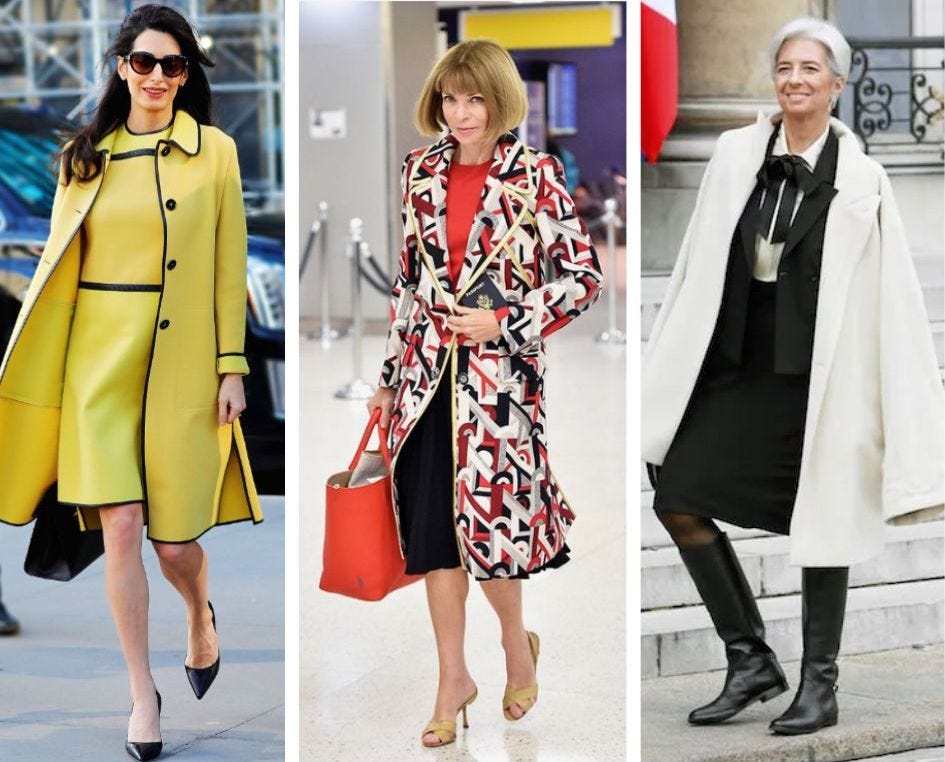SS 26: What We Wear: The End of the Corporate Uniform
I’ve been reflecting a lot on how the way we present ourselves at work has evolved, especially after the pandemic. This observation comes up every time I work with a high-level executive woman.
In the past, dressing for a corporate environment was straightforward.
You could simply grab a black, grey, or blue suit, pair it with a blouse, or wear a sheath dress and a cardigan, add a smart pump, and you were done. It was akin to wearing a school uniform—minimal variety, minimal thought required.
Back then, bringing your personality to the workplace was risky.
Given that most top-level leaders were male, you wanted to be recognized for your intelligence rather than your looks. Anything too fashionably stylish could be misinterpreted as frivolous and superficial, especially in fields like law, finance, or government. Industries like advertising and the arts were more relaxed but were exceptions.
Today, the rules have changed.
Clinging to the old corporate uniform no longer works; it can make you appear outdated.
This shift in dressing is here to stay.
A recent article from Women’s Wear Daily, dated July 8th, 2024, titled "British Politics: Individualism is Back in Fashion," discusses the transformation in the wardrobes of English politicians. It highlights how Prime Minister Keir Starmer’s cabinet ministers have embraced self-expression, transitioning from traditional, ill-fitting suits to vibrant, personalized outfits.
It say, "The recent parade of new cabinet ministers into No. 10 Downing Street resembled a red carpet event more than a political transition. Ministers showcased a spectrum of colors—from turquoise to bright red to fuchsia—and chose dresses or unique top-and-trouser combinations over conventional suits."
This is revolutionary news because it opens the possibility of thinking differently about dressing!
Consider it an invitation to reassess every executive woman's question:
What to wear?
As an expert in this field, adhering to the established dress code might still be necessary if you work in a highly traditional corporate environment. However, as demonstrated by the changes at the top levels of government in a traditionally conservative country like England, the tides are shifting.
As a leader and high executive, you may think she is correct, but what should I do?
First, embrace the change and understand the science behind dressing.
Do not rush to the nearest boutique to buy a random fuchsia suit or spend hours searching online for a printed dress to match the “summer casual” dress code to update your closet.
Second, this is an opportunity to hone and redefine your style.
And what does this mean? An invitation to learn about who you are today.
To read beyond the lines and bring your values, beliefs, and story to the forefront of your outfits.
Third, understand your context and your audience.
Your work environment has a culture. What are the nonverbal guidelines? For example, I work with an executive woman whose client is the Defense State Department. She does not feel comfortable or appropriate wearing a red suit to a meeting. However, a beige and brown polka dot shirt is very welcome. If you wonder why, comment, and I will answer you.
Fourth, understand your body design and color palette.
Learn what your best colors are and their meanings are. Read these previous articles: The Influence of Color in Your Style and Your Workplace and Color is Culture, and Color Is Culture Part 2 to deepen your knowledge.
These are the foundations for building a long-lasting style that aligns with yourself and your role.
But before all this, answer these questions to get you started and motivated.
How do you want to feel in your clothes?
What image do you want to project?
What message do you want your clothes to send?
What impact do you want to make with your style? Are you aiming to be relatable, friendly, intelligent, inclusive, sharp, unique, a forward thinker, or a boss, to name a few?
What story do you want to tell with your clothes? How do you want to show your values, heritage, or family history?
How can your style help you connect and influence? Often, a unique piece in your outfit can create a new conversation and connection with colleagues, clients, and board members. Your style will imply a set of assumptions and lead to interpretations.
What is it about your style that you want to be remembered?
What kind of environment are you working in, and how do your clothes need to behave to support you? Is it hybrid, five days in the office, or does it involve client visits, traveling, and speaking engagements?
The evolution of workplace attire signals more than just a shift in fashion; it represents a broader cultural change.
By embracing this transformation, you will enhance your professional image and pave the way for greater authenticity and self-expression in your career.
As you navigate these changes, remember that your style is a powerful tool that influences your confidence, changes perceptions (see pictures above), fosters connections and drives your professional success.
(And if you need extra help to achieve it, I am here to guide you all the way!)






